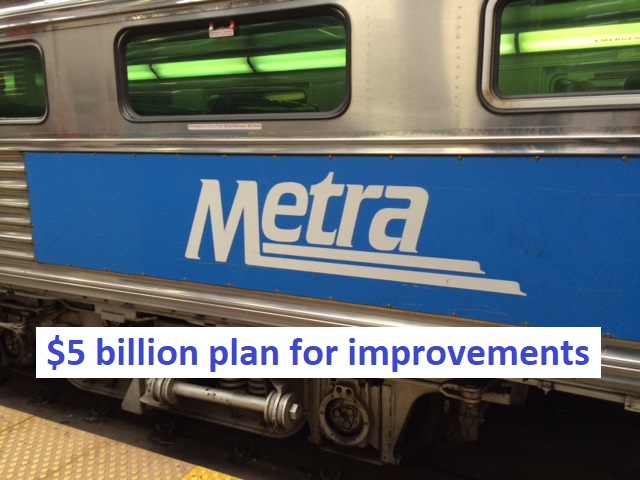Metra's $5 billion
plan for improvements
10-year capital funding plan it is seeking
from the state of Illinois
Trains Magazine, By David Lassen | January 7, 2019
Metra has been cash-starved for a long time. But if that changes, the Chicago-area commuter rail system has a plan.
As part of his presentation Monday at the National Railroad Construction and Maintenance Association Conference, Chief Operating Officer and Deputy Executive Director Bruce Marcheschi not only outlined Metra’s capital plans for 2019, but the far greater vision that would come with a $5-billion, 10-year capital funding plan it is seeking from the state of Illinois.
Marcheschi called this “The Ask,” and it’s a big one – not only because of the dollar figure involved, but also because he noted it has been 10 years there was a state plan covering Metra capital needs. With a new governor, J.B. Pritzker, taking office on Wednesday, Marcheschi and Metra hope that might change.
“We’re hoping transportation for the region, and the state in general, might get a good capital bill,” he said. “… There’s a lot of things we need to do.”
What does “The Ask” entail?
- Rolling Stock: 40 new locomotives, 400 new coaches, and conversion of 54 existing locomotives to A.C. traction motors. Some of Metra’s coaches, for example, date to the 1950s. “We’re putting an RFP [Request For Proposal] together to go onto the street sometime in this first quarter, looking at at least 400 coach car purchases,” Marcheschi said.
- Station improvements: More warming shelters, with improved lighting and security cameras. “The station is really the first place our passengers get our experience,” Marcheschi said. “Is it clean? Is it safe? Am I well-guided? Do I know where I’m going? If we can’t get that first, then we miss the first step of the whole customer service program that we want.
- Service improvements: More express trains, which requires more capacity – not just in terms of cars, but yard space for those car, along with track improvements to run at higher speeds, more crossovers for dispatching flexibility, and extended platforms to accommodate longer trains.
- Refurbishment or replacement of 10 bridges a year – which still would address just a fraction of the more than 400 bridges Metra uses that are a century old or older.
- Electrification of the Rock Island District, the 40-mile route between downtown Chicago’s La Salle Street Station and Joliet, Ill. The Metra-owned line currently sees 67 trains each weekday. “We feel electrification is more reliable, it’s more efficient, and it reduces emissions. So that’s something that we’re looking at.”
- Replacement of the complex junction at Tower A-2, two miles from Chicago Union Station. “Seven lines of train service traverse it every day; 337 train movements every day,” Marcheschi said. “If something happens there, it can spoil the whole day.” A study of design options for A-2 is set to begin in a matter of weeks, he said. “Right now, we’re looking at a flyover. We’ve got the Union Pacific and Metra cross each other over a set of 12 double-slip switches. … We’re just starting the design concept right now.”
- The 75th Street Corridor Improvement Project, to address one of Chicago’s most notorious rail bottlenecks. Some $474 million of this project has been funded. But the full $1.1 billion 75th Street plan would also include a connection between the Metra Rock Island District and the line used by SouthWest Service trains; that would allow SouthWest trains to originate at LaSalle Street Station rather than Union Station, opening up platform capacity at Union Station. Related changes would also include increasing capacity at LaSalle Street and a section of triple track to reach the station.
- Service to O’Hare International Airport. The lightly-used Metra O’Hare Transfer station (which sees 10 weekday-only round trips on the North Central Service) would see dedicated service every half-hour from both Union Station and the nearby Ogilvie Transportation Center.
“Again, that’s $5 billion over 10 years,” Marcheschi said. “If we get that, we’re in a good spot.”
In the meantime, there are the capital plans for 2019 – in comparison, a modest $185.6 million, all from federal funding, which will include $40.3 million for rolling stock, $54.6 million for track and structures, and $31.8 million for signals, electrical, and communications. The latter figure, Marcheschi noted, reflects the last year Metra has to divert capital funds to positive train control installation.
Bridges are going to be a major focus in Metra’s 2019 capital spending, reflecting the system’s aging infrastructure. The largest bridge projects in the budget are $12 million to replace bridge A-32 on the Milwaukee North line, with design beginning in the first quarter of 2019 and construction starting in 2020; $7 million to rehabilitate the timber Morgan Street bridge on the Rock Island District, with construction to begin later in 2019; and $4 million to rehab the 96th Street bridge on the Rock Island District.
Station projects on tap include a $40 million rehab of the Van Buren Street station on the Metra Electric line, a structure which dates to 1896. Design work is scheduled to be completed by mid year, with construction, in phases, beginning in 2020. There will also be a new Peterson Ridge station on the UP North line, budged at $15 million, and a rebuild of the 59th/60th Street Station on the Metra Electric, near the site for the Barack Obama Presidential Center in Jackson Park, near the University of Chicago. That will be a $14 million project. “We were just going to do a rehab,” Marcheschi said, “but when they decided to put the Obama library in the vicinity, we said, ‘Well, it can’t be just a rehab. It’s got to be much more than that.’ And it will be.”
